Can the act of gliding also perform as an act of writing? The sweeping movements of a glider aircraft through the sky already create circular traces in GPS tracking applications—an asemic script that is written at the intersection between wind, wing, and piloting skill. Can such gestures provide the basis for more complex acts of inscription, in which human and atmospheric agencies combine to parse the vital experience of flight into poetry?
Beyond this, what might we learn from such a practice, concerning the relationships between the human and more-than-human dimensions of being in the world? The practicalities of gliding flight are almost never characterised in terms beyond their own end, as a means of traversing the air safely, but we might also consider how these often visceral encounters with a multitude of airborne forces and volumes can provide a source of important critical insights – as a way of renewing our awareness, once more, concerning the material and ecological structures of existence and experience.
Finally, given the current fascination with generative media, data visualisation, and AI systems more broadly, what can we learn by applying these technologies and techniques for the task of making real such an unusual project? What new possibilities of insight and imagination might we develop in examining the intersection of the digital, the atmospheric, and the ecological?
Lines of Flight was developed over the course of 2023 and 2024. It was instigated at the generous invitation of writer Dr. J.R. Carpenter, as part of the research project Weather Reports Wind as Media, Model, Experience, whose members also include Prof. Ryan Bishop, Prof. Birgit Schneider, Prof. Jussi Parikka, and Maximilian Hepach.
Publications
An interactive, creative-critical exploration of the project now forms part of a special issue of the journal Media+Environment, which was published in December 2024. It is available at this link here. The project application is also available directly at this site, here. If you have difficulty with access, it is also mirrored at itch.io, at this link here.
Lines of Flight was also discussed as part of an article by Jussi Parikka, Paolo Patelli and May Ee Wong, “Ecocritique between Landscape and Data: The Environmental Audiotour” (2024), published in the Electronic Book Review. It is available at this link here.
